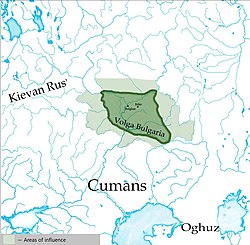
Back Wolga-Bulgarye Afrikaans بلغار الفولغا Arabic Bulgaria del Volga AST İdil Bulqar xanlığı Azerbaijani ایدیل بولقارلاری AZB Волга буйы Болғары Bashkir Волжская Булгарыя Byelorussian Волжка България Bulgarian ভলগা বুলগেরিয়া Bengali/Bangla Bulgària del Volga Catalan
Volga Bulgaria | |||||||||
|---|---|---|---|---|---|---|---|---|---|
| late 9th century–1240s | |||||||||
 | |||||||||
| Status | Vassals of the Khazars (late 9th century-969)[1] | ||||||||
| Capital | Bolghar Bilär | ||||||||
| Common languages | Bulgar | ||||||||
| Religion | Tengrism, later Sunni Islam (after Almish Iltäbär) | ||||||||
| Government | Monarchy | ||||||||
| Ruler | |||||||||
• 9th century | Şilki | ||||||||
• 10th century | Almış, Ahmad, Mikaʾil, Abdallah, Talib, Muʾmin I, Muʾmin II, Shamgun | ||||||||
• 11th-13th centuries | Khaidar, Mukhammad, Saʾid, Baradz, Ibrahim, Otyak, Ghabdula Chelbir, Ilham Khan | ||||||||
| Historical era | Middle Ages | ||||||||
• Established | late 9th century | ||||||||
• Conversion to Islam | 922 | ||||||||
| 1240s | |||||||||
| |||||||||
| Today part of | Russia | ||||||||
Volga Bulgaria or Volga–Kama Bulgaria (sometimes referred to as the Volga Bulgar Emirate[2]) was a historical Bulgar[3][4][5] state that existed between the 9th and 13th centuries around the confluence of the Volga and Kama River, in what is now European Russia. Volga Bulgaria was a multi-ethnic state with large numbers of Bulgars, Finno-Ugrians, Varangians, and East Slavs.[6] Its strategic position allowed it to create a local trade monopoly with Norse, Cumans, and Pannonian Avars.[7]
- ^ Di Cosmo, Nicola (2018). Warfare in Inner Asian History (500-1800). Brill. pp. 139–140. ISBN 9789004391789.
- ^ Mako, Gerald (2016). "Volga Bulgar Emirate". The Encyclopedia of Empire: 1–3. doi:10.1002/9781118455074.wbeoe009. ISBN 978-1-118-44064-3.
- ^ Shpakovsky, Viacheslav; Nicolle, David (2013). Armies of the Volga Bulgars & Khanate of Kazan. p. 14.
- ^ Champion, Timothy (2014). Nationalism and Archaeology in Europe. p. 227.
- ^ Koesel, Karrie J. (2014). Religion and Authoritarianism: Cooperation, Conflict, and the Consequences. p. 103.
- ^ Reuter, Timothy, ed. (1995). The New Cambridge medieval history. Vol. III, c. 900-1024. Cambridge [England] ; New York, NY, USA : Cambridge University Press. p. 504. ISBN 978-0-521-36291-7.
- ^ Popovski, Ivan (2017-05-10). A Short History of South East Europe. Lulu Press, Inc. ISBN 9781365953941. Archived from the original on 2023-01-21. Retrieved 2020-10-03.